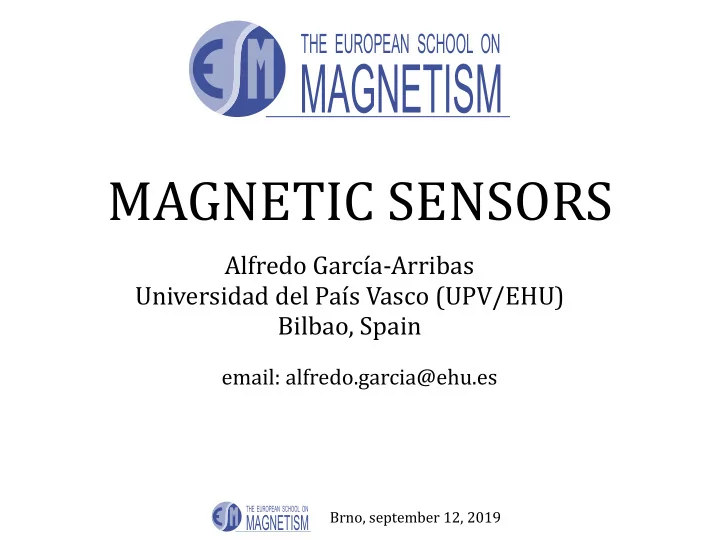

THE EUROPEAN SCHOOL ON MAGNETISM MAGNETIC SENSORS Alfredo García-Arribas Universidad del País Vasco (UPV/EHU) Bilbao, Spain email: alfredo.garcia@ehu.es THE EUROPEAN SCHOOL ON Brno, september 12, 2019 MAGNETISM
Contents 1. Introduction and basic concepts a. Magnetic sensors (what and what not). b. Magnetic materials for sensors . 2. Sensing principles and examples a. Inductive sensors (reluctance, eddy-current, LVDT, 9luxgate). b. SQUID sensors (magnetometers, magneto-encephalography). c. Hall effect sensors (magnetic compass, encoders). d. Magnetoresistance sensors: AMR, GMR, TMR . e. Magnetoelastic sensors (torque sensors, anti-shoplifting labels). THE EUROPEAN SCHOOL ON Brno, september 12, 2019 ! 4 MAGNETISM
1. Introduction Magnetic sensors: what and what not Very general de9inition: A magnetic sensor is a measuring or detection device that makes use of magnetic phenomena. Reed relay Anti-lock Braking System (ABS) Magnetoencephalography THE EUROPEAN SCHOOL ON Brno, september 12, 2019 ! 5 MAGNETISM
1. Introduction. Magnetic sensors: what and what not Selective review: We will not talk about every kind of magnetic sensors. Only most relevant technologies will be presented, illustrated with selected examples. No 9ine details: The basic operating principle will be examined, but not the technological complexity of a working device. drive H output 9luxgate principle 9luxgate space magnetometer THE EUROPEAN SCHOOL ON Brno, september 12, 2019 ! 6 MAGNETISM
1. Introduction. Magnetic sensors: what and what not Focused description: Sensor technology combines several disciplines: electronics, signal conditioning, instrumentation, metrology , etc … We will focus on the magnetic principles. In particular, we will not directly deal with very important aspects and characteristics of sensors, such as calibration, accuracy, resolution, precision, noise, … Recommended reading : C. W. de Silva, Sensor systems: fundamentals and applications (CRC press, 2017). ISBN: 9781498716246 THE EUROPEAN SCHOOL ON Brno, september 12, 2019 ! 7 MAGNETISM
1. Introduction Magnetic materials for sensors Main requisites: B Large permeability • high sensitivity to small magnetic bields • intensify the bield • concentration and guiding of magnetic blux B = µ H Low magnetic hysteresis • well debined magnetic state H • reduce losses Soft magnetic materials Other requisites: Mechanical, thermal, … properties Availability, price, … THE EUROPEAN SCHOOL ON Brno, september 12, 2019 ! 8 MAGNETISM
Introduction Magnetic materials for sensors Fe-Ni alloys: Permalloy (Fe 100-x Ni x ) presents very low crystalline anisotropy and magnetostriction. With x ~ 80 at. %, µ > 10 5 . µ 0 M s ~1 T. Other related materials: • Supermalloy (with Molybdenum) • Mumetal (with Copper) Extensive documentation on properties : R. M. Bozorth, Ferromagnetism (IEEE press, 1991). ISBN: 0-7803-1032-2 THE EUROPEAN SCHOOL ON Brno, september 12, 2019 ! 9 MAGNETISM
Introduction Magnetic materials for sensors Amorphous alloys: Amorphous materials lack crystalline order. The atomic conbiguration presents topological and chemical disorder (if alloys). (a) (c) (d) (b) gas pressure Amorphous ferromagnetic materials can be obtained by induction molten alloy coil alloying Fe, Co, Ni (~80 at. %) with metalloids as B, P, Si, C, etc (~20 at.%) by rapid quenching from the melt (10 6 degrees per second). rotating cold Also called metallic glasses. wheel THE EUROPEAN SCHOOL ON Brno, september 12, 2019 ! 10 MAGNETISM
Introduction Magnetic materials for sensors Amorphous alloys: Amorphous materials lack crystalline order. The atomic conbiguration presents topological and chemical disorder (if alloys). (a) (c) (d) (b) gas pressure Amorphous ferromagnetic materials can be obtained by induction molten alloy coil alloying Fe, Co, Ni (~80 at. %) with metalloids as B, P, Si, C, etc (~20 at.%) by rapid quenching from the melt (10 6 degrees per J. M. Silveyra et al , Science 362 , eaao0195 (2018). second). rotating cold Also called metallic glasses. wheel THE EUROPEAN SCHOOL ON Brno, september 12, 2019 ! 10 MAGNETISM
Introduction Magnetic materials for sensors The softness comes from • lack of crystalline anisotropy • no defects of grain boundaries for domain wall pinning. As an example: Hysteresis loop of a Co-Fe-B amorphous ribbon Fe 40 Ni 38 Mo 4 B 18 (Metglas 2628SC) µ max = 4 × 10 5 . µ 0 M s = 0.88 T. F.E. Luborsky, Amorphous ferromagnets , in: Handbook of Ferromagnetic Materials , Vol. 1, Chapter 6. Elsevier (1980) pp. 451-529. ISBN 9780444853110 P. Hansen, Magnetic amorphous alloys , in: Handbook of Magnetic Materials, Chapter 4. Elsevier (1991) pp. 289-452. Ackland et al. AIP Advances 8, 056129 (2018) THE EUROPEAN SCHOOL ON Brno, september 12, 2019 ! 11 MAGNETISM
Contents 1. Introduction and basic concepts a. Magnetic sensors (what and what not). b. Magnetic materials for sensors . 2. Sensing principles and examples a. Inductive sensors (reluctance, eddy-current, LVDT, 9luxgate). b. SQUID sensors (magnetometers, magneto-encephalography). c. Hall effect sensors (magnetic compass, encoders). d. Magnetoresistance sensors: AMR, GMR, TMR . e. Magnetoelastic sensors (torque sensors, anti-shoplifting labels). THE EUROPEAN SCHOOL ON Brno, september 12, 2019 ! 12 MAGNETISM
<latexit sha1_base64="pE7x4LHNgmCVSlimFEBHsd8osG0=">ACAXicbZA7SwNBFIVnfcb4ilraDAbBKuxGQRslYKOFEME8MAlhdnI3GTI7u8zcFWJI5V+w1d5ObP0ltv4SJ3ELk3iqM/ecgXs/P5bCoOt+OQuLS8srq5m17PrG5tZ2bme3aqJEc6jwSEa67jMDUioEAJ9VgDC30JNb9/Oc5rD6CNiNQdDmJohayrRCA4Qzu6b8Y9Qc/pDb1u5/JuwZ2IzhsvNXmSqtzOfTc7EU9CUMglM6bhuTG2hkyj4BJG2WZiIGa8z7ownOw5odBpCn2gE7eUw0WGjMIfdsJGfbMbDYe/psZBKFCwEebUnuNRfE3byQYnLWGQsUJguK2ZLMgkRQjOsZBO0IDRzmwhnEt7O6U95hmHC20rIXizSKYN9ViwTsuFG9P8qWLFE+G7JMDckQ8ckpK5IqUSYVwosgzeSGvzpPz5rw7H7/VBSf9s0em5Hz+ALT+ldo=</latexit> <latexit sha1_base64="QC+zC+hZnrzhkVvp5PW0HTxwC6w=">ACG3icbZA7TwJBFIVn8YX4WrW0mUBMbCS7aKNhsTGEhN5JCwhs8NdmD7yMxdEiT0/gn/gq32dsbWwtZf4oAUAp5mztxzJpn7+YkUGh3ny8qsrK6tb2Q3c1vbO7t79v5BTcep4lDlsYxVw2capIigigIlNBIFLPQl1P3+zSvD0BpEUf3OEygFbJuJALBGZpR2857A6Yg0ULGEb2ip9QLFOjDvWSnhibE8dtu+AUnanosnFnpkBmqrTtb68T8zSECLlkWjdJ8HWiCkUXMI456UaEsb7rAuj6QZjehzEimIP6PQ+12Ch1sPQN52QYU8vZpPhv5lGEFEI+GDSyTYG0t+8mWJw2RqJKEkRIm5KJgtSTGmE1C0IxRwlENjGFfC/J3yHjNw0ODMGSjuIoJlUysV3bNi6e68UL6e4cmSI5InJ8QlF6RMbkmFVAknj+SZvJBX68l6s96tj9qxpq9OSRzsj5/AJEboJU=</latexit> <latexit sha1_base64="ZilcWbru3MBunmu2FZftCVIpTE=">ACAXicbZA7SwNBFIVnfcb4ilraDAbBKuxGQRslYKNgEcE8MAlhdnI3GTI7u8zcFWJI5V+w1d5ObP0ltv4SJ3ELk3iqM/ecgXs/P5bCoOt+OQuLS8srq5m17PrG5tZ2bme3aqJEc6jwSEa67jMDUioEAJ9VgDC30JNb9/Oc5rD6CNiNQdDmJohayrRCA4Qzu6b8Y9Qc/pDb1u5/JuwZ2IzhsvNXmSqtzOfTc7EU9CUMglM6bhuTG2hkyj4BJG2WZiIGa8z7ownOw5odBpCn2gE7eUw0WGjMIfdsJGfbMbDYe/psZBKFCwEebUnuNRfE3byQYnLWGQsUJguK2ZLMgkRQjOsZBO0IDRzmwhnEt7O6U95hmHC20rIXizSKYN9ViwTsuFG9P8qWLFE+G7JMDckQ8ckpK5IqUSYVwosgzeSGvzpPz5rw7H7/VBSf9s0em5Hz+ALNoldk=</latexit> <latexit sha1_base64="Vy0eF3Q2GCPWJqac90xg8LqSVhw=">ACHXicbZC7TgJBFIZnvSLeUEubiWhiRXbRBsN0cYSo1wSlpDZ4cBOmL1k5iwJEl7Al/AVbLW3M7bG1idxwC0E/Kv/nP+fZM7nxVJotO0va2FxaXlNbOWXd/Y3NrO7exWdZQoDhUeyUjVPaZBihAqKFBCPVbAk9Czetdj/NaH5QWUXiPgxiaAeuGoiM4Q7Nq5Q7d2Bf0groixNYdfvAh1cj6vJ2hLQ9GfWolcvbBXsiOm+c1ORJqnIr9+2I54ECKXTOuGY8fYHDKFgksYZd1EQ8x4j3VhOLlhRI86kaLoA53MUw0WaD0IPNMJGPp6Nhsv/80gDwAeTUnOnwfQ3byTYOW8ORgnCE3JZN1EkxomNUtC0UcJQDYxhXwvydcp8pxtEAzRoziyCeVMtFpyTQvH2NF+6TPFkyD45IMfEIWekRG5ImVQIJ4/kmbyQV+vJerPerY/f6oKVvtkjU7I+fwD5pqFV</latexit> 2. Sensing principles and examples Inductive sensors Basic underlaying principle: Faraday’s induction law Z ε = − d φ ~ � = B · d ~ s dt Michael S Faraday (1791- 1867) source: physicsabout.com Different con9igurations, based on: • changes on self-inductance φ = LI • changes on mutual-inductance φ = MI THE EUROPEAN SCHOOL ON Brno, september 12, 2019 ! 13 MAGNETISM
Recommend
More recommend